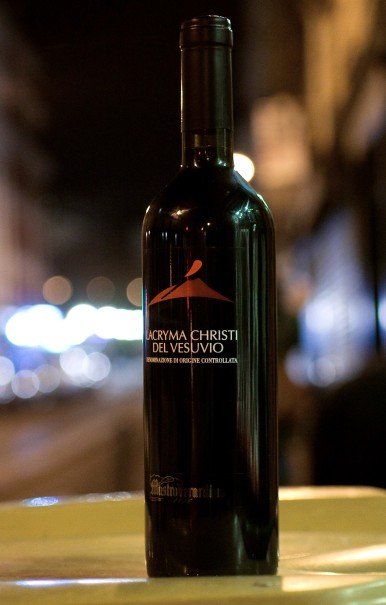
A Quest for the Sacred Tears of Summer in a Colder Time

A Quest for the Sacred Tears of Summer in a Colder Time
Lacryma Christi in Naples and Paris
Perhaps it was out of a sense of self-preservation, but I never did see the Bay of Naples. Assuming the famous vista, ruled over ominously by Mount Vesuvius, spawned the saying “See Naples and die,” I chose to remain in the old town and eat. There, I figured, I was safely shielded from a sight so allegedly perfect it renders all others obsolete and makes further living a waste of time.
The locals say that Jesus Christ didn’t have such an option when he passed through Naples 2,000 years ago. But then, he was already on his way out. Legend goes that as Jesus was ascending into heaven he looked down to Naples and wept for the beauty of the world he was leaving behind. His tears fell on the volcanic slopes of Vesuvius, and from them grape vines sprung forth. Lucky for him, he didn’t also try the food, or he may not have gone so willingly.
For in the old town, within the sweltering bustle of Di Matteo’s, a deceptively basic pizzeria, I had accidentally found myself experiencing a kind of culinary zenith. I was stuffed: stuffed on wood-fired dough, on pomodoro, and on mozzarella like discs of white sunlight. People had warned me of the life changing capacity of Neapolitan cuisine, but this … Jesus wept!
Then Marco, my Italian guide, led me from Di Matteo’s, out onto the Via dei Tribunali. And he produced from his bag a bottle of Lacryma Christi: wine from the vineyards on the slopes of Vesuvius. Its name literally means “Christ’s tears.”
We shouldered down Naples’ medieval alleys, broiling with life in the summer dusk, toward the Piazza Luigi Miraglia, where the café terraces merged with the street drinkers. There, we found a place among the swelling crowds, and Marco opened the bottle.
He told me the story of Christ crying over Naples, and how the taste of Lacryma Christi is believed by wine experts to be the modern wine most similar to those drunk in ancient Rome. What a combination! Grown on the slopes of a volcano, fertilized by holy tears, and filled with the flavor of a fallen world. I must have been so overcome by the swirl of these tropes, or the swirl of the Neapolitan piazza, that I have since forgot the wine’s actual taste.
Summer’s long over now, and—to reach for an obvious, but nevertheless true, turn of phrase—in my adopted home of Paris there is more than a temporal chill in the air. In the past few weeks, we’ve all of us been painfully reminded that beauty is not the only thing that causes tears to fall. I decided to go in search of Lacryma Christi; I wanted to recall a warmer time.
Yet attempting to find a specific Italian wine in Paris is no easy feat. The French belief in the superiority of their booze runs deep. “World” wines are curios, seldom given the shelf-space dedicated to even a single minor region of France. In liquor stores across Paris, wherever I asked for Lacryma Christi, I was denied, flashed disapproving looks, told: “We do, though, have many excellent French wines.”
The search became a quest. Uttering the wine’s name to legions of unhelpful shop staff felt like speaking a Harry Potter-esque incantation: “Lacryma Christi?” I uttered. The most common response: “La crème de quoi?”
The possibility that I might taste the summer again grew fainter with every failure, and, of course, my imagined memory of the wine grew all the more spectacular. After three hours of fruitless flâneur-ing, I felt sure I was searching for the greatest wine ever created.
I found it at last in a store called Lavinia, not just the largest wine store in France, but in all of Europe. At last in my hands, the bottle had a magical weight. The minimalist illustration of Vesuvius on its label—a teardrop of lava escaping its summit—looked like a hieroglyph. Here was stoppered history.
I drank the Lacryma Christi with friends in an Oberkampf bar. The barkeeper—himself Italian—uncorked it for us in exchange for a glass. I know very little about how to write tasting notes. The official ones talk of cherries, of red fruits, and back pepper. To me, though, the Lacryma Christi tasted of smoke and of earth, of ancient empire and of the Piazza Luigi Miraglia at twilight in the height of a Neapolitan summer.